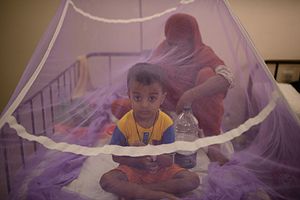Last Friday, when Didarul Alam’s 7-year-old son was diagnosed with dengue fever, Alam spent around six hours visiting three hospitals in Bangladesh’s capital Dhaka before he could convince a doctor to admit his son as a patient.
Almost all the hospitals in the South Asian city were so full of dengue patients that doctors were refusing to take any more.
As a last ditch effort, Alam took his son to Dhaka Medical College and Hospital (DMCH) — the largest government run hospital in the country — and got his son a makeshift bed at one of the walkways in the hospital.
“My son is still ill. His platelet count is below 30,000. I am getting scared for him,” Alam told this correspondent on Sunday.
The dengue outbreak in Bangladesh is getting worse. In one 24-hour span (from 3 p.m. July 29 to 3 p.m. July 30), 1,335 new dengue patients were admitted to the hospital, the highest number of single-day dengue fever admissions ever.
Dengue is carried by the Aedes mosquito and has no cure or vaccine yet. It first appeared in Bangladesh in 2000, when 93 people died of the disease. Since 2003, the death rate has gradually declined with zero fatalities in some years, according to data from the Directorate-General of Health Services (DGHS). Bangladesh has seen more than 6,000 cases of dengue only three times in the last 20 years, in 2002, 2016, and 2018.
But so far this year, the number of cases of dengue fever has broken all records. From January through July 30, DGHS data officially recorded 15,369 dengue patients. In July alone, 13,182 patients were diagnosed with dengue.
This year’s outbreak has claimed at least eight lives so far, according to DGHS data. But based on media reports and conversations with different government and private hospitals in the city, the total number of fatalities is higher: dengue fever is estimated to have caused at least 30 deaths so far.
Explaining the disparity in the number of deaths, officials of the Institute of Epidemiology, Disease Control and Research (IEDCR) said that without collecting blood samples and other information from the deceased to confirm the cause of the death, the government can’t “definitively” declare the death was caused by dengue.
ATM Nazrul Islam, deputy director of Central Hospital of Dhaka, said that people are practically gripped by panic over dengue.
“It’s not only the cases of dengue that’s alarming. A huge number of people are coming to our hospital with regular fever but suspecting that they are suffering from dengue,” he said.
Lutful Ehsan Fatmi, the head of the Department of Child Health at Holy Family Hospital of Dhaka, told this correspondent that his hospital is struggling to tackle the number of dengue patients.
“Finding no other options, we needed to open a new section just to tackle the new dengue patients,” he said.
“Certainly, it’s an epidemic,” he added. “A large number of people becoming infected with the same disease at the same time fit the definition of an epidemic.”
Dhaka South City Corporation (DSCC) Mayor Sayeed Khokon, however, in a media briefing said that the prevalence of dengue virus in Dhaka cannot yet be called an “epidemic.”
He also claimed that a particular quarter is trying to exaggerate the real situation.
Earlier, on July 17, the High Court slammed the two city corporations of Dhaka for their failure to prevent the mosquito menace in the capital.
A HC bench said, “Dengue fever has turned into a terrible situation as 21 to 22 people including children have reportedly died and hundreds of people have been affected with dengue fever. There is nothing left for the dengue fever to become an epidemic.”
The carrier of dengue fever, the Aedes mosquito, breeds in clear water and prefers a subtropical climate and urban or semi-urban landscapes.
Dhaka, a megacity of around 17 million, fits the bill. It has thousands of under construction building sites, which turn into pools of stagnant water during monsoon season and become breeding ground for mosquitoes. For instance, the metro rail mega-project is under construction on Dhaka’s main thoroughfare, from the airport to business hub Motijheel. Many parts of that route have already been dug, and rainwater can be seen pooling in the construction zones.
The Aedes mosquito can breed in those stagnant waters in the rainy season starting from early May, Sanya Tahmina, director of disease control at DGHS told this correspondent.
Dengue has spread to 63 out of Bangladesh’s 64 districts, affecting a total of 1,845 patients outside of Dhaka. But DGHS records show that over 88 percent of the dengue cases in the country are reported in the capital city.
Tahmina said that most of the dengue patients outside Dhaka were in the capital when they contacted the virus, but travelled to their ancestral home afterwards. “They have spread the disease there,” she said.
Meanwhile, Permethrin, the main insecticide used by the two city corporations in Dhaka, has proven ineffective against Aedes mosquitoes, as per a study of International Center for Diarrheal Disease Research, Bangladesh.
Brig. General Mominur Rahman, chief health officer of Dhaka North City Corporation said that they are aware of the findings and they are going to change the main insecticide soon.
“We have to go through bureaucratic procedures,” Rahman said. “The switch is not that easy a process.”
Faisal Mahmud is a Dhaka-based journalist.

































